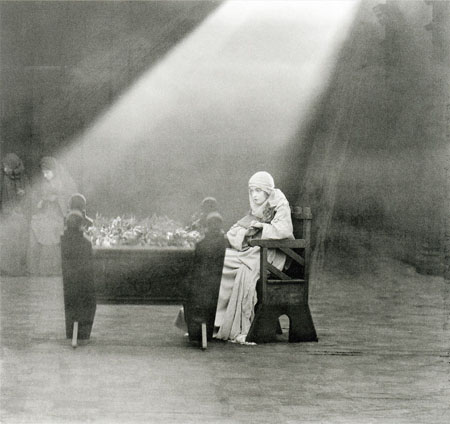On Monday, the UK’s Eureka Entertainment released special DVD and Blu-ray editions of D.W. Griffith‘s The Birth of a Nation (1915) as part of its Masters of Cinema series and, as it happens, today sees a new restoration of Griffith’s Intolerance (1916) beginning a week-long engagement at New York’s Film Forum. Countless essays, some more tortured than others, have been written about Birth, and one of the best is Michael Sicinski‘s—and I’m not just saying that because it appeared here in Keyframe just over two months ago.
Still, Birth hardly never fails to startle those seeing it for the first time. The Guardian‘s Xan Brooks may or may not have been avoiding it, but with the MoC release, he finally decided that “the time seemed right for the full unabridged horror. The legends do not lie. The Birth of a Nation is every bit as astounding as it’s cracked up to be, and for good reasons as well as bad.” And of course, he struggles with the same questions that have pestered viewers for nearly a century now: “Does the film’s technical excellence excuse its racist leanings? Of course it doesn’t; the movie is rancid. And yet…” And yet. “I’m not convinced that good art only qualifies as good art if it complements our view of what goodness means.”
“Three hours long, and full of ideas and techniques which swiftly became and in many cases have remained standard, The Birth of a Nation is one of those great earthquakes that level an art-form and cause it to be built anew,” writes David Bennun at the Quietus. “Not only did it transform the movies; by doing so, it helped to transform the dominant culture of the last and (thus far, despite all claims to the contrary) this century: American popular culture. Meaning its aftershocks are felt even now.” What’s more, he argues: “It prefigures and coalesces almost every element of contemporary reactionary attitudes in the U.S.”
“When it was released, its unnervingly compelling account of star-crossed Civil War families and the Ku Klux Klan was the subject of protests and censorship battles,” Nicolas Rapold reminds us in the New York Times. And “with his next feature, Intolerance, Griffith confronted criticism head-on as only an artist intoxicated by his chosen medium could: with bolder filmmaking, bigger stories and, of course, giant elephant statues and throngs of Babylonian dancers…. It’s often described as Griffith’s cinematic apology for Birth of a Nation, which makes it sound like the most expensive community service ever undertaken. The truth of Griffith’s motives is a bit more complicated. Brute success, for one thing, paved the way for Intolerance, or at least its size. The Birth of a Nation grossed a fortune, even with hundreds of thousands of dollars in legal bills relating to censorship…. ‘He didn’t feel he had anything to apologize for,’ Kevin Brownlow, the silent-film historian who interviewed some of Griffith’s collaborators, said by telephone from England. While it might be more comforting to imagine Intolerance as a mea culpa, the film is more of a j’accuse.” And Rapold elaborates.
“Out of the cradle endlessly rocking comes a tale interweaving four struggles across centuries,” writes Aaron Cutler, reviewing Intolerance in the Voice. “Babylon falls; a man called Christ is persecuted by Romans for being too radical; 16th-century French Catholic rulers slaughter Protestants; and, in modern times, the poor flail against the will of the most intolerant force imaginable—the law. The pure, simple love between couples is threatened by other people’s ignorance.” The film “barrels forth like a freight train to condemn progress as mankind’s enemy.”
Griffith’s “conception of film form was borne of his desire to wrestle cinema from the confines of novelty and elevate it to the realm of high art,” writes Drew Hunt at the House Next Door. “His controversial socio-cultural outlook—okay, racism—isn’t sufficient enough grounds to disregard his enormous influence on both mainstream and avant-garde filmmaking. If anything, his unselfconscious, unwavering desire to essentially imprint himself on the cinematic image, even at the expense of his public perception, ultimately made him a martyr for the cause; as Stan Brakhage hyperbolically but poetically claimed, ‘hunks of Christ broke off in Griffith’s psyche.'”
For Glenn Kenny, “what really killed me on seeing the movie was the elasticity and innovation of its cinematic language. Both the freedom and the concentration with which Griffith composes his images and orchestrates their effects is constantly dazzling…. In Carl Theodor Dreyer and Ordet: My Summer with the Danish Filmmaker, Jan Wahl‘s splendid, and just recently published, account, Wahl recalls that great director’s thoughts on this Griffith film.” Wahl: “According to Dreyer‘s own words, ‘I went home completely dazed, overwhelmed by a new rhythm and the number of close-ups. In particular those of Lillian Gish at the conclusion.’ […] On that night, Dreyer became aware of how far one might aim in the medium.” Glenn Kenny: “I think that Intolerance still retains the power to instill that awareness.”
Update, 8/4: The New Yorker‘s Richard Brody on Intolerance: “The harrowing battles—replete with graphically simulated decapitations and blood-spurting spear wounds—are sparked by conflicts over religion, money, and sex, which Griffith magnifies, with histrionic artifice, to a sort of movie opera. The plunging and roving camera provides visceral thrills; ecstatic special effects capture the sacred (the Crucifixion) and the profane (combat in the Great War); and Griffith’s trademark closeups lend a quivering lip or a trembling hand the tragic grandeur of historical cataclysm.”
For news and tips throughout the day every day, follow @KeyframeDaily on Twitter and/or the RSS feed. Get Keyframe Daily in your inbox by signing in at fandor.com/daily.




